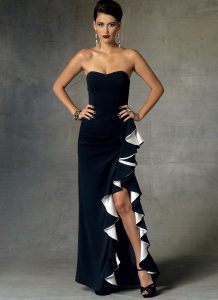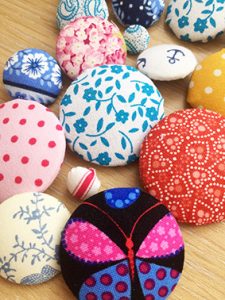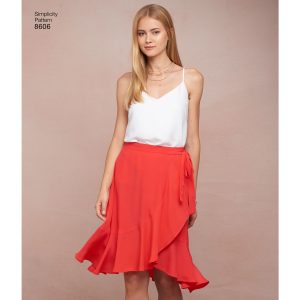Great British Sewing Bee – Top Tips For Choosing and Sewing Specialist Fabrics
Things are hotting up in the Great British Sewing Bee Studio as contestants tackled another set of patterns testing their skills and fabric choices. Below are some of my top tips for sewing similar projects using specialist fabrics requiring extra care.

Make your own Spanish inspired dress with a fabulous cascading ruffle. (Vogue Pattern 1426)
- If you choose transparent but crisp fabrics such as organza or a voile for a little top, as Liz and Claire did, be aware that the inside seams will show so like Claire, use French Seams. Stitch with WRONG sides together taking a 1cm seam, then trim to 3mm. Turn through and stitch again with RIGHT sides together, and the seam on the very edge and take a small 6mm seam.
- Using a contrast binding is perfect for these crisp transparent fabrics. Ready made binding will already be cut on the bias and folded, but if making your own, do cut strips on the bias (45 degree angle to the selvedge) so that it will curve around the neckline without ripples.
- Take care that you don’t stretch a round neckline as you sew – stay stitch it before you attach the binding by sewing, with a regular stitch length just inside the seam allowance.
- If you can, use an adjustable bias binding foot to attach binding. It is such a wonderful gadget! It has a scroll or channel on the front, through which you feed the folded binding. The fabric is then slipped in between the edges of the binding and you stitch it in place, front and back in one pass so very neatly – and quickly!
- If you choose beaded or sequin fabric, as Nicole did, then you will have to remove the beads from the seam line before sewing, which does take time and patience. You need to crush the beads not just cut the thread holding them which may result in too many coming off! Some softer sequins can be stitched through, but again it is best to cut them away from the seam line.

Self covered buttons are easy to make and so versatile
- Self covered buttons are a real boon in a sewists workbox as they ensure matching buttons without having to hunt the haberdashery! If you don’t have the button tool or don’t want to use a hammer (!) choose the plastic self covered buttons. These are simple to use and clip together easily. (See my article

A simpler version of the skirt, this wrap has a ruffled hemline (Burda 8606)
on using self covered buttons)
- Scuba fabric is a great fabric for bodycom dresses and skirts, but it is quite heavy so do definitely interface waistbands. You shouldn’t need fastenings as it is stretchy so that saves a job!
- When making a skirt that needs to fit snugly across the hips and derriere, chose one with some Lycra or Spandex in it. It will help hold the shape and fit snugly.
- Adding interfacing to a waistband is really a must as it adds extra support and stability and will help prevent the waistband stretching during wear. If using iron-on interfacing, do make sure you fix it in place permanently. Cover with a press cloth and fuse with a hot steam iron for 10 seconds at a time.
